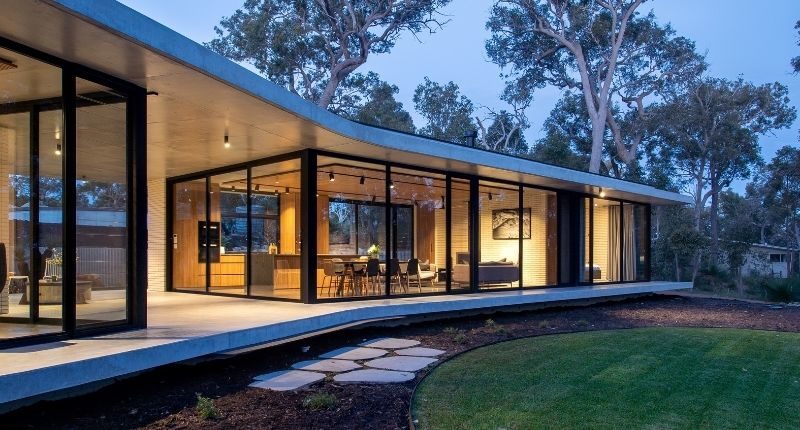- The design "hugged" the view
- Home is only one room wide along its length
- Designed to be self-sufficient, and resistant to fire and ember attack
It’s interesting how people choose an architect. Sometimes people will see a home, in a magazine or in person, and keep the architect in mind for many years until the opportunity comes along to build their own home. This was the case for this Tim Wright designed home.
The clients had stayed in one of Tim Wright’s award winning homes in Western Australia’s south west a few years prior and had loved it. When they decided to build their own holiday home in Vintners Ridge in the hinterland hills of Dunsborough they called Mr Wright.

The property slopes from the road, located to the north of the site, down a hill – with beautiful views of dense forest and a river located to the south.
By the time the clients met with Mr Wright they had many ideas in mind, generally for a higher form, but were quickly convinced by Mr Wright’s lowline concept – which he described as a boomerang shaped form which “hugged” the view.
“Standing on the site I just wanted to reach my arms out and hug the view. So the form was like two arms embracing the views to the forest and the south,” Mr Wright explained.

The two arms or wings of the home are broken by an outdoor alfresco space. “I wanted the clients to feel the environment; for them to be a part of the landscape when they moved from one wing of the home to the other,” said Mr Wright.
This outdoor space also provided separation and privacy between the two wings – with one pavilion containing the living space and master bedroom, and the other containing guest bedrooms.

Mr Wright noted that the planning may seem counter-intuitive to some – with the parent’s bedroom in a separate pavilion to what may become children’s rooms.
“We analysed this in the design process and considered having all bedrooms in one pavilion but ultimately settled on separation,” Mr Wright said.
“This was because for the home to be feasible it had to work as a rental property (on Private Properties) – the idea being that you could have two couples on a holiday and be quite separate.”

The pavilion design of the home is transparent and narrow to make the most of the site. Being only one room wide along its length with extensive glazing, the home’s occupants are immersed in the landscape and the view to the south.
Even from the garden on the northern side of the home the occupants could look straight through to the view.
The narrow, single room width also works from a passive design and sustainability perspective – maximising access to northern light and promoting cross ventilation.

The house is constructed entirely of masonry and concrete for durability and to minimise maintenance.
In particular, the concrete roof serves many purposes – enhancing cooling with its metal deck overlay, power generation through its photovoltaic cell array, and water collection for the on-site tanks, making the home virtually self-sufficient.
The absolute resistance to fire and ember attack is also an extremely positive outcome of this form of construction.

While the entire design process was collaborative, it was in furnishing the home that the clients really put their personal stamp on the project.
“All of the furniture was selected by the clients and they did a wonderful job of styling the house,” said Mr Wright.
“I love it when clients do the interiors themselves. It adds their personality and for me this completes the project.”
~~
Written by Sandy Anghie. Photography by Matthew Moyes.
This story was originally published in The Architect magazine, an official publication of the Australian Institute of Architects. It has been edited for republication by The Property Tribune.
The Property Tribune thanks the Australian Institute of Architects for the opportunity to republish the work, and shine a light on Australian architecture.








